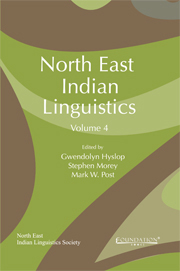Book contents
- Frontmatter
- Contents
- About the Contributors
- Foreword
- A Note from the Editors
- History, Contact and Evolution
- Bodo-Garo Grammar
- Orthography, Poetics and Text
- New Descriptions
- 10 Notes on Usoi Tripura Phonetics and Phonology
- 11 Phonological Description of the Hajong Language
- Classifiers
- Eastern Indo-Aryan Grammar
- Austroasiatic
11 - Phonological Description of the Hajong Language
from New Descriptions
Published online by Cambridge University Press: 05 May 2013
- Frontmatter
- Contents
- About the Contributors
- Foreword
- A Note from the Editors
- History, Contact and Evolution
- Bodo-Garo Grammar
- Orthography, Poetics and Text
- New Descriptions
- 10 Notes on Usoi Tripura Phonetics and Phonology
- 11 Phonological Description of the Hajong Language
- Classifiers
- Eastern Indo-Aryan Grammar
- Austroasiatic
Summary
Introduction
The basis for the current research is our linguistic work among the Hajong community in 2004–2006. The language is spoken by approximately 80 to 100 thousand people (Hajong 2002: 9) in the North-East Indian states of Meghalaya and Assam.
Hajong is classified as an Indo-Aryan (IA) language. It has some degree of similarity with Assamese and Bengali, the two IA languages spoken in the region. At the same time, certain grammatical similarities such as case marking can be found between Hajong and some Tibeto-Burman (TB) languages spoken in the same geographic location (Phillips 2008).
The paper presents the distribution of the vowel and consonant segments, with contrastive pairs, syllable and stress patterns where applicable. At the end of each section we will compare the phonological features of Hajong with the corresponding ones in TB, represented by Garo and IA, represented by Assamese. The scope of the current study covers segments distribution patterns at the syllable level, with some comments on their position within the word.
Analysis of consonants
In this chapter, we will talk about consonant segments of Hajong. A segment is defined as “any discrete unit or phone, produced by the vocal apparatus, or a representation of such a unit” (Loos 1996: S). The next linguistic level above the segment is the syllable. Since our analysis is based mostly on syllable structures, it is important to establish the definition of this notion. A syllable typically consists of a central peak of sonority (usually a vowel) and optional less sonorant segments before and/or after the peak (Loos 1996: S), commonly called onset and coda.
- Type
- Chapter
- Information
- North East Indian Linguistics , pp. 216 - 240Publisher: Foundation BooksPrint publication year: 2012
- 1
- Cited by



